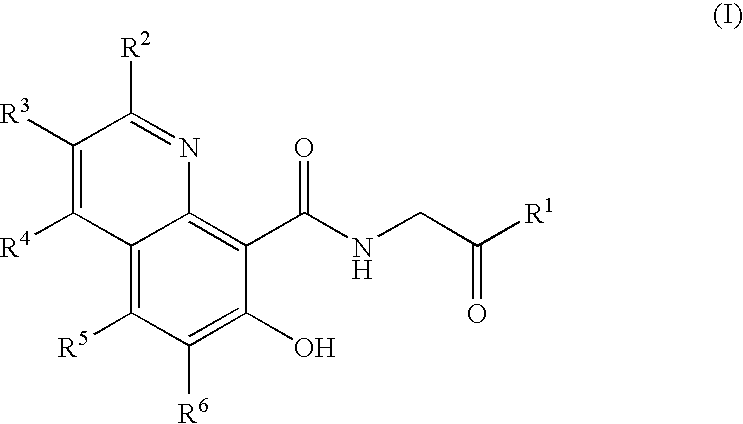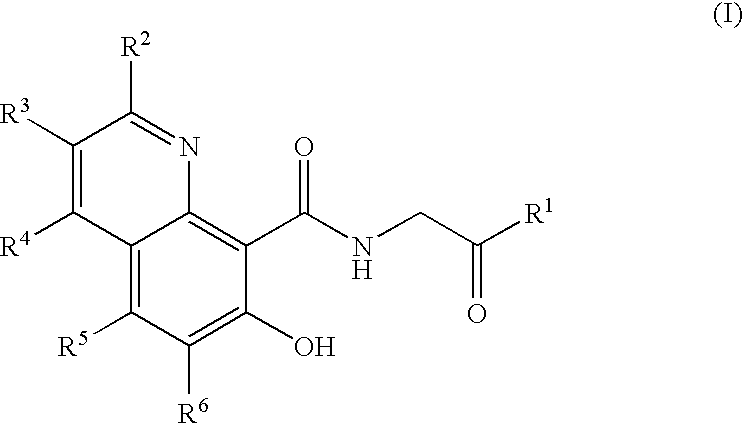Prolyl Hydroxylase Inhibitors
a technology of prolyl hydroxylase and inhibitor, which is applied in the direction of drug composition, biocide, extracellular fluid disorder, etc., can solve the problems of reduced oxygen levels in the blood, ubiquitination of hif-alpha and subsequent degradation, and achieve the effect of increasing the production of erythropoietin and epo
- Summary
- Abstract
- Description
- Claims
- Application Information
AI Technical Summary
Benefits of technology
Problems solved by technology
Method used
Image
Examples
example 1
[0090]
N-[7-hydroxy-8-quinolinyl)carbonyl]glycine
1a) 7-(methyloxy)-8-quinolinecarboxylic acid
[0091]A mixture of 2-amino-6-(methyloxy)benzoic acid (1.00 g, 6.00 mmol) and acrolein (0.445 mL, 6.00 mmol) in 1,4-dioxane (6.0 mL) was heated to 200° C. for 20 min. in a Biotage Initiator® microwave synthesizer (http: / / www.biotage.com). The mixture was concentrated in vacuo and purified via flash column chromatography (0-10% methanol in dichloromethane) to afford the title compound (0.430 g, 35%) as a light orange solid. 1H NMR (400 MHz, DMSO-d6) δ ppm 13.1 (br. s., 1H), 8.85 (dd, J=4.3, 1.8 Hz, 1H), 8.35 (dd, J=8.3, 1.8 Hz, 1H), 8.06 (d, J=9.1 Hz, 1H), 7.60 (d, J=9.1 Hz, 1H), 7.43 (dd, J=8.3, 4.3 Hz, 1H), 3.96 (s, 3H). MS (ES+) m / e 204 [M+H]+.
1b) Ethyl N-{[7-(methyloxy)-8-quinolinyl]carbonyl}glycinate
[0092]To a solution of the compound from Example 1a) (0.203 g, 1.00 mmol) and glycine ethyl ester hydrochloride (0.279 g, 2.00 mmol) in N,N-dimethylformamide (5.0 mL) were added triethylamine (...
example 2
[0094]
N-[7-hydroxy-3-phenyl-8-quinolinyl)carbonyl]glycine
2a) 7-(methyloxy)-3-phenyl-8-quinolinecarboxylic acid
[0095]A mixture of 2-amino-6-(methyloxy)benzoic acid (0.250 g, 1.496 mmol) and 2-phenylpropenal (prepared by the method of Nsanzumuhire, C.; Clément, J.-L.; Ouari, O.; Karoui, H.; Finet, J.-P.; Tordo, P. Tetrahedron Lett. 2004, 45, 6385-6389) (0.198 g, 1.496 mmol) in 1,4-dioxane (2.0 mL) was heated to 200° C. for 20 min. in a Biotage Initiator® microwave synthesizer. The mixture was concentrated in vacuo and purified via flash column chromatography (0-10% methanol in dichloromethane) to afford the title compound (0.062 g, 15%) as a light orange solid. 1H NMR (400 MHz, DMSO-d6) δ ppm 13.1 (br. s., 1H), 9.22 (d, J=2.3 Hz, 1H), 8.64 (d, J=2.3 Hz, 1H), 8.13 (d, J=9.1 Hz, 1H), 7.87 (d, J=7.3 Hz, 2H), 7.64 (d, J=9.1 Hz, 1H), 7.55 (t, J=7.7 Hz, 2H), 7.45 (t, J=7.3 Hz, 1H), 3.98 (s, 3H). MS (ES+) m / e 280 [M+H]+.
2b) Ethyl N-{[7-(methyloxy)-3-phenyl-8-quinolinyl]carbonyl}glycinate
[009...
example 3
[0098]
N-[(3-bromo-7-hydroxy-8-quinolinyl)carbonyl]glycine
3a) 3-bromo-7-hydroxy-8-quinolinecarboxylic acid
[0099]A solution of 2-bromoacrolein (prepared by the method of Nicolaou, K. C.; Brenzovich, W. E.; Bulger, P. G.; Francis, T. M., Org. Biomol. Chem. 2006, 4, 2119-2157) (0.60 mL, 7.42 mmol) in glacial acetic acid (20.0 mL) at ambient temperature was titrated to the appearance of a faint reddish color with bromine (0.382 mL, 7.42 mmol). 2-amino-6-(methyloxy)benzoic acid (1.24 g, 7.42 mmol) was added, and the solution was heated to 100° C. for 2 h. Upon cooling, the solution was concentrated in vacuo and purified via flash column chromatography (20-100% ethyl acetate in hexanes) to afford the title compound (0.312 g, 16%) as a light yellow solid. 1H NMR (400 MHz, DMSO-d6) δ ppm 14.6 (s, 1H), 9.12 (d, J=2.3 Hz, 1H), 9.03 (d, J=2.3 Hz, 1H), 8.18 (d, J=9.3 Hz, 1H), 7.46 (d, J=9.3 Hz, 1H). MS (ES+) m / e 268 / 270 [M+H]+.
3b) Ethyl N-{[7-(methyloxy)-3-phenyl-8-quinolinyl]carbonyl}glycinate
[...
PUM
| Property | Measurement | Unit |
|---|---|---|
| weight | aaaaa | aaaaa |
| weight | aaaaa | aaaaa |
| weight | aaaaa | aaaaa |
Abstract
Description
Claims
Application Information
 Login to View More
Login to View More - R&D
- Intellectual Property
- Life Sciences
- Materials
- Tech Scout
- Unparalleled Data Quality
- Higher Quality Content
- 60% Fewer Hallucinations
Browse by: Latest US Patents, China's latest patents, Technical Efficacy Thesaurus, Application Domain, Technology Topic, Popular Technical Reports.
© 2025 PatSnap. All rights reserved.Legal|Privacy policy|Modern Slavery Act Transparency Statement|Sitemap|About US| Contact US: help@patsnap.com



